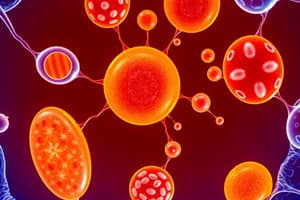Podcast
Questions and Answers
What is a cell?
What is a cell?
The smallest structural and functional unit of a living organism.
What is an organelle?
What is an organelle?
A membrane-bound compartment within the cell, held in the cytoplasm.
What is the function of the nucleus?
What is the function of the nucleus?
Holds the cell's genetic information and coordinates activities.
What does DNA stand for?
What does DNA stand for?
What are genes?
What are genes?
What is the function of ribosomes?
What is the function of ribosomes?
What does the rough endoplasmic reticulum do?
What does the rough endoplasmic reticulum do?
What is the function of the Golgi body?
What is the function of the Golgi body?
What do lysosomes contain?
What do lysosomes contain?
What are enzymes?
What are enzymes?
In which type of cells are chloroplasts found?
In which type of cells are chloroplasts found?
What is the role of mitochondria?
What is the role of mitochondria?
Flashcards are hidden until you start studying
Study Notes
Cells and Organelles
- Cells are the smallest structural and functional units of life.
- Organelles are membrane-bound compartments within cells, residing in the cytoplasm.
Organelles that Make and Process Cell Substances
-
Nucleus:
- Contains the cell's genetic information and chromosomes (DNA).
- Functions as the control center, coordinating cellular activities and providing instructions.
- Encased by a nuclear membrane with nuclear pores.
- Houses the nucleolus, the site of ribosome synthesis, comprising proteins and RNA.
-
DNA:
- Stands for deoxyribonucleic acid, the primary genetic material of cells.
- Contains essential instructions for cellular functions.
-
Genes:
- Segments of DNA that carry the 'code' for protein synthesis.
-
Ribosomes:
- Composed of ribosomal RNA and protein, often not classified as organelles since they lack membranes.
- Responsible for protein synthesis, found either attached to the endoplasmic reticulum or freely floating in the cytoplasm.
-
Endoplasmic Reticulum (ER):
- Connected to the nucleus, serving as a transport network.
- Rough ER:
- Studded with ribosomes; modifies and processes proteins.
- Smooth ER:
- Lacks ribosomes; involved in lipid synthesis.
-
Golgi Body:
- Composed of flat, stacked membrane sacs.
- Functions to package and process substances produced by the cell.
- Vesicles formed post-processing transport materials to various cell regions or outside the cell.
-
Lysosomes:
- Vesicles produced by the Golgi body containing digestive enzymes.
- Engage in breaking down cellular waste.
-
Enzymes:
- Proteins that act as catalysts, accelerating biochemical reactions.
Organelles Involved in Energy Transformation
-
Chloroplasts:
- Disk-shaped organelles unique to plant cells.
- Contain their own DNA and the green pigment chlorophyll.
- Utilize sunlight for photosynthesis, converting light energy into glucose.
-
Mitochondria:
- Not detailed in the provided information but crucial for energy production, converting biochemical energy from nutrients into ATP (adenosine triphosphate).
Studying That Suits You
Use AI to generate personalized quizzes and flashcards to suit your learning preferences.




